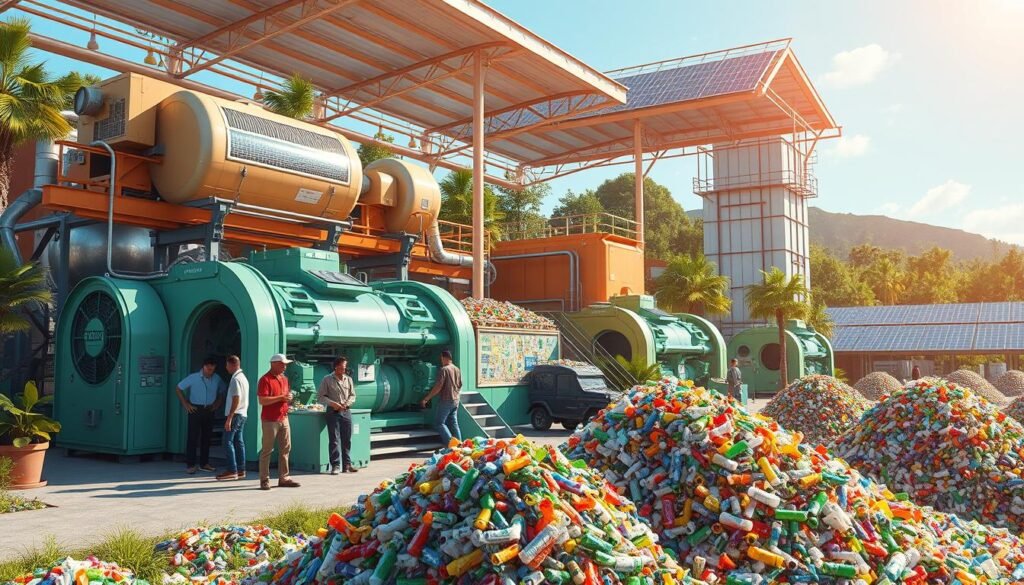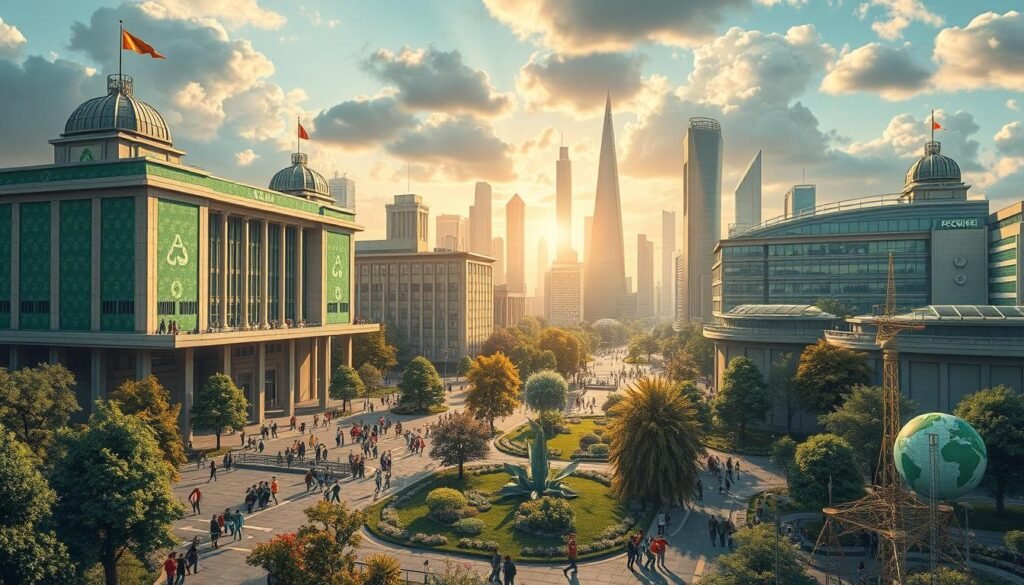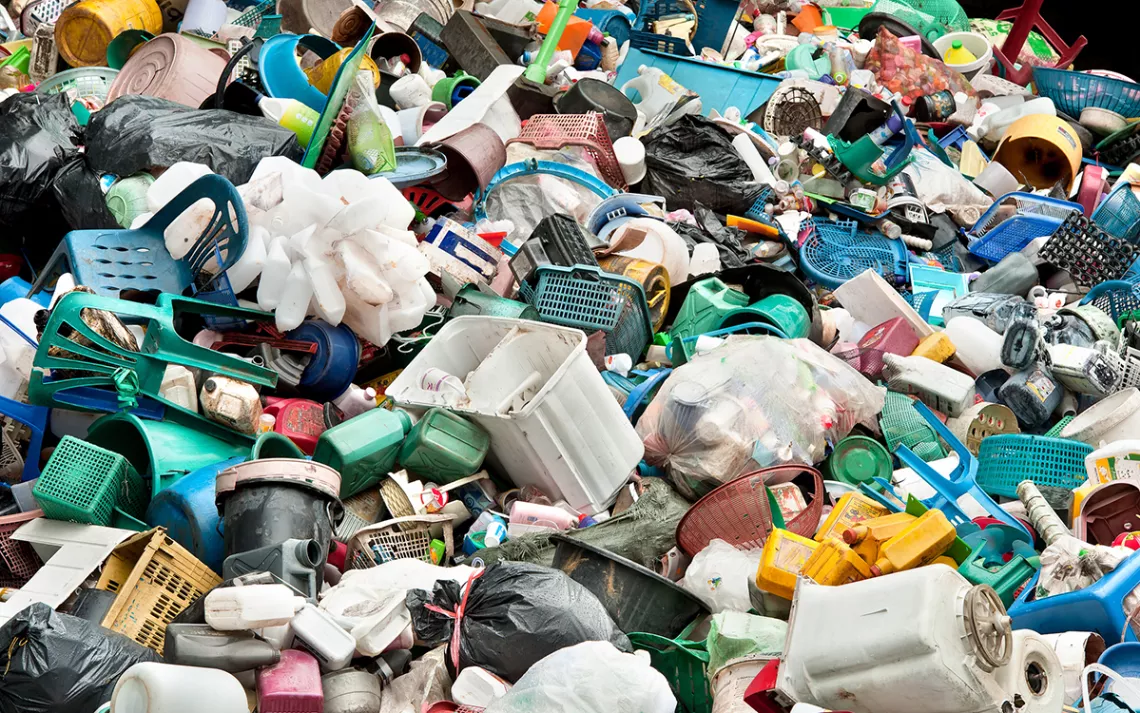In the vital talks about saving our planet, focusing on sustainable plastic recycling practices is key. We lead in environmentally responsible recycling, aiming to surpass worldwide goals. Our goal is to cut down on the environmental harm. This piece examines the cutting-edge methods and technologies we use for green plastic waste management.
We look at how well current recycling works and introduce our new methods. These mix technical accuracy with a deep care for the environment. We aim to change how we use and throw away plastic, aiming for renewal and carefulness.
We’re about to show you how the latest in recycling can completely change waste management. The next parts will highlight how our innovative and eco-focused efforts shape our planet-friendly recycling answers.

Key Takeaways
- Revolutionizing waste management through sustainable plastic recycling practices.
- Adhering to strict global sustainability goals for environmentally responsible recycling.
- Making big strides in lessening plastics’ environmental effects.
- Blending technological advances with eco-awareness for top green plastic waste management solutions.
- Pushing for a big change in the plastic lifecycle, promoting reuse and thoughtful disposal.
The Importance of Eco-Friendly Approaches in Plastic Recycling
We’re in an environmental crisis. Adopting eco-conscious recycling practices is key to decreasing the environmental impact of plastic. We believe using sustainable recycling methods is good for the planet and businesses.
Eco-friendly plastic recycling helps our planet. It lessens waste and uses less new materials. Companies going green help protect the environment a lot.
- Reduction in landfill waste
- Lower energy consumption during production
- Decreased pollution and greenhouse gas emissions
These actions make our world more sustainable. They also show companies are responsible leaders.
| Feature | Impact | Example |
|---|---|---|
| Biodegradable materials | Reduces long-term pollution | PLA plastics in packaging |
| Chemical recycling | Enables the reuse of polymers | ChemCycling by BASF |
| Modular recycling plants | Increases recycling rates | Mobile units by TerraCycle |
Case studies show green tactics help. They’re good for the earth and business. It also boosts a company’s image and efficiency.
We push eco-friendly actions as our duty. It’s key to our promise of leading environmental care in recycling. By working together, we can use resources more wisely.
Innovative Technologies in Plastic Recycling
To better our environment, embracing innovative recycling technologies is crucial. We’re seeing great strides in chemical recycling processes, bioplastics development, and the use of machine learning in recycling. These advances are reshaping how we handle plastic waste.
Chemical Recycling and Polymer Breakdown
Chemical recycling focuses on breaking down plastic molecules into simpler forms that we can reuse. This strategy turns waste into resources by using renewable materials for plastics. It makes a circular economy possible. Methods like these allow us to recycle materials that we couldn’t before.
Bioplastics: The Future of Sustainable Plastic
In bioplastics development, the goal is to create plastics from biodegradable materials. These are made from renewable resources, helping us rely less on fossil fuels. The creation and recycling of bioplastics lessen our environmental footprint. This aligns with worldwide sustainability efforts, making bioplastics vital for future manufacturing.
Enhancing Efficiency with Machine Learning
Adding machine learning and AI to recycling — through smart recycling systems — is changing the game. AI improves recycling by making it more efficient and accurate. This lowers costs and increases the amount we can process. Machine learning algorithms help us make better decisions for more effective recycling and resource use.
| Technology | Primary Benefit | Impact on Recycling Efficiency |
|---|---|---|
| Chemical Recycling | Advanced breakdown of complex polymers | Enables recycling of previously non-recyclable plastics |
| Bioplastics | Reduces environmental footprint | Encourages the use of renewable resources |
| AI and Machine Learning | Enhances sorting and processing accuracy | Increases overall recycling rates and efficiency |
Plastic Recycling
In plastic waste management, knowing how effective plastic recycling works is key. It starts from when we first collect it to when we make new products. Each step is crucial to ensure the process works well.
Recycling best practices start with sorting plastic waste carefully. This prevents the wrong types from mixing and helps create high-quality recycled products. Advances in technology also boost recycling facility capabilities.
- Pre-sorting at the source to eliminate non-recyclable materials.
- Use of advanced sorting technology like infrared scanners and air classifiers.
- Regular maintenance and calibration of recycling machinery to ensure peak performance.
Let’s talk about what comes out of effective plastic recycling. The table below shows types of recycled plastics and what they’re turned into. It shows how waste plastic can become something useful again.
| Type of Recycled Plastic | Primary Use |
|---|---|
| PET (Polyethylene Terephthalate) | Food and beverage containers, polyester textile fibers |
| HDPE (High-Density Polyethylene) | Detergent bottles, piping, plastic lumber |
| LDPE (Low-Density Polyethylene) | Shopping bags, flexible packaging films |
| PP (Polypropylene) | Automotive parts, industrial fibers, food containers |
| PS (Polystyrene) | Insulation materials, disposable cutlery, CD cases |
In short, good recycling best practices help manage plastic waste. They also save resources. This meets our goal to care for the environment and innovate. By promoting a circular economy, we use resources more efficiently. This leads us to a greener future.
Challenges and Solutions in Eco-Friendly Plastic Recycling
We face many challenges in making recycling sustainable. We need smart solutions to improve waste collection and plastic quality control. Strong community involvement is also key.
Overcoming Collection and Sorting Hurdles
Efficient waste collection and sorting are crucial first steps. We use advanced technologies to separate different plastics. This makes recycling more efficient and ensures only clean materials are processed.
Dealing with Contaminants in Recycling Processes
Contamination is a big problem in recycling. We use sophisticated technology and strict quality checks to get rid of impurities. This helps keep recycled products clean and pure.
Improving Public Participation in Recycling Programs
To increase recycling, we need to get the community involved. We run campaigns to teach people about recycling’s benefits. They also learn how to recycle correctly. This way, community support improves recycling’s success.

We work hard to overcome recycling challenges. Our goal is to turn these challenges into chances for better recycling and community service. Our efforts not only solve current problems but also prepare us for a sustainable recycling future. We aim to conserve the environment and use resources wisely.
Recycling at the Community Level: Case Studies
Local initiatives and partnerships are crucial in the plastic recycling world. They help local areas act responsibly with the environment. Plus, they show everyone how sustainable practices can work across the nation.
Successful Community-Based Initiatives
Model recycling programs have shown how effective grassroots efforts can be. Led by community leaders and nonprofits, they work to make communities greener.
In some small towns, every home and business participates in unique recycling plans. They also join workshops and seminars. This is a big part of teaching people about protecting the environment.
Public-Private Partnerships for Recycling
Successful recycling needs both public and private sectors to work together. Local governments and companies have created advanced recycling systems this way.
They work on making waste collection better, improving sorting, and using new tech. This makes recycling more efficient.
Education and Outreach Strategies
Educational programs are essential to improve recycling habits. They create a big change in how communities recycle through targeted learning.
Interactive campaigns and vibrant workshops draw in people of all ages. They focus on practical recycling tips. This helps everyone recycle more and better.
| Initiative Type | Description | Community Impact |
|---|---|---|
| Grassroots Recycling Campaigns | Local movements led by community members to increase recycling awareness and participation. | Enhances local recycling rates and fosters a culture of sustainability. |
| Public-Private Collaboration | Partnerships formed between municipalities and private companies to enhance recycling infrastructure. | Improves efficiency of recycling processes and introduces advanced technological solutions. |
| Environmental Education Programs | Programs aimed at educating the public on the importance and methods of proper recycling practices. | Leads to more informed community members who participate actively in recycling efforts. |
The Role of Government in Promoting Eco-Friendly Recycling
Government plays a key role in pushing eco-friendly recycling. They do this through effective governmental recycling policies, strong legislation for waste management, and state-level recycling initiatives. These efforts are vital for a sustainable future. They help protect our planet, ensure economic growth, and keep the public healthy.

By introducing legislation for waste management, governments can set recycling rules. These aren’t just rules but also motivate new and better recycling methods. It encourages industries to adopt innovative recycling technologies.
- Regulations that mandate recycling practices in industries and communities
- Subsidies and incentives for businesses that adopt green recycling practices
- Public awareness campaigns to elevate the importance of eco-friendly recycling
State-level recycling initiatives show how policies work on the ground. They are examples for nationwide policies. They prove recycling can be tailored to fit different areas, reflecting their unique needs and situations.
| State | Recycling Initiative | Impact Assessment |
|---|---|---|
| California | Comprehensive Beverage Container Recycling Program | Marked reduction in waste and increased recycling rates |
| New York | Electronic Waste Recycling Act | Significant drop in electronic waste, promoting safer disposal methods |
| Michigan | Deposit Return Scheme | High recovery rates of beverage containers |
We must continue to support strong governmental recycling policies. They are crucial for promoting recycling culture. They also provide the needed education and resources to recycle effectively. This helps our environment greatly.
Impact of Plastic Recycling on Climate Change
All over the world, industries are trying to lessen their harm to the environment. The focus is on recycling and carbon footprint management. Plastic recycling is key in the fight against climate change. It’s not just good for the earth; it’s crucial. Recycling helps cut down on greenhouse gas emissions, which is good for the climate.
Reducing Greenhouse Gas Emissions Through Recycling
Recycling plastic is crucial in lowering harmful gases in our atmosphere. When we recycle, we use less new plastic. New plastic needs a lot of energy to make, which adds to pollution. Sustainability metrics for recycling prove that recycling more lowers carbon emissions significantly. It’s a great way to fight climate change.
Life Cycle Assessment of Recycled Plastics
Understanding the climate benefits of recycling requires a deep look. An environmental life cycle analysis is needed. It checks the impact of a product from start to finish. Recycled plastics harm the environment less than new plastics. This shows how important recycling is.
| Indicator | Virgin Plastic | Recycled Plastic |
|---|---|---|
| Energy Consumption | High | Reduced |
| CO2 Emissions | Higher | Lower |
| Water Use | Extensive | Minimal |
| Waste Generated | Significant | Decreased |
Looking at the comparison, recycled plastics save energy and cut CO2 emissions. They also use less water and create less waste. So, boosting recycling can make a big difference for our planet.
Conclusion
We’ve looked into how plastic recycling is changing and the impact of new, eco-friendly methods. We talked about the importance of advanced technologies and how they’re shaping the future. This helps us manage plastic waste better and protect our environment.
We also discussed how bioplastics, machine learning, and chemical recycling are making a difference. These technologies offer hope. They show us ways businesses and individuals can help protect our planet. By working together, we’re making strides toward a cleaner future.
By combining our knowledge with the efforts of business owners, experts, and communities, we’re on the brink of a major change. This team-up of tech and dedication will transform how we recycle plastics. Together, we’re working to ensure a sustainable world for us and future generations.
FAQ
What are eco-friendly plastic recycling solutions?
Eco-friendly plastic recycling solutions focus on the environment. They include sustainable practices, responsible recycling, and green waste management. The goal is to reduce pollution and save resources during recycling.
Why is it important to adopt eco-friendly approaches in plastic recycling?
Using eco-friendly recycling methods is key because of plastic’s environmental harm. These methods lessen our ecological footprint and help us meet sustainability goals. They’re good for nature and business over time.
How do innovative technologies improve plastic recycling?
Innovations like chemical recycling and bioplastics are changing recycling for the better. They make breaking down polymers easier and help sort and process waste smarter. This supports a circle economy by using biodegradable materials.
What does the plastic recycling process entail?
The plastic recycling process starts with gathering wastes and ends with making new products. It involves collecting, sorting, cleaning, and processing plastics. Following best practices ensures the recycling is effective.
What challenges are faced in eco-friendly plastic recycling, and how can they be solved?
Recycling eco-friendly plastics faces problems like sorting waste and dealing with contamination. Solutions include better sorting tech and quality control. Encouraging people to recycle more helps too.
Can you provide examples of successful community recycling programs?
Community programs that work well often start from the ground up. They might partner with businesses and focus on teaching the community. These efforts lead to strong recycling outcomes and support green habits.
What is the government’s role in promoting eco-friendly recycling?
Government action is vital in recycling. Laws and policies help, as do subsidies for green efforts. Local recycling programs get a boost from this support, encouraging eco-friendly practices.
How does plastic recycling impact climate change?
Recycling plastic helps fight climate change by cutting emissions. It uses less energy than creating new plastic does. Studies on recycled plastics show the benefits for the climate.
